- Share this article
- Subscribe to our newsletter
Trees, forests and land-use in drylands: The first global assessment
The report Trees, forests and land-use in drylands: The first global assessment was published by the Food and Agriculture Organization of the United Nations (FAO) at the High-Level Meeting on Forests at the U.N. COP25 climate summit in December 2019. According to report, more than a quarter of the world's forest area is located in drylands, and trees are present on almost a third of the world's dryland regions.
The assessment complements FAO's Global Forest Resources Assessments but differs in that its primary data are developed through visual interpretation of freely available satellite images in a global team effort using FAO's Open Foris Collect Earth tool.
The new report engaged more than 200 experts and a series of regional workshops in collaboration with partner universities, research institutes, governments and non-governmental organisations worldwide, and draws on information from 213 782 sample plots, each measuring around half a hectare.
While specific instances require reality checks on the ground, the interpretation of high-resolution remote-sensing images presented in the assessment can help policymakers identify optimal investment strategies to combat land degradation and desertification, conserve biodiversity, support livelihoods and help increase the resilience of landscapes and communities, especially in the face of climate change, FAO says.
18 per cent of drylands are forest
Drylands, comprising hyperarid, arid, semi-arid and dry sub-humid zones, cover about 6.1 billion hectares, or 41 per cent of the Earth's land surface. Of these, some 1.1 billion hectares (18 per cent) consist of forest, according to FAO's assessment.
Drylands are home to an estimated 2 billion people, half the world's livestock, and more than a third of global biodiversity hotspots, and provide critical migration points for birds. Their ecosystems are vulnerable to water shortage, drought, desertification, land degradation and climate change impacts. The world's drylands are expected to expand by 10 to 23 percent by the end of the 21st century, with dangerous ramifications for food security, livelihoods and human welfare.
Globally, about 18 per cent of drylands are forest, just over half of which have canopy density above 70 per cent, while barren land accounts for 28 per cent, grassland 25 per cent and cropland 14 per cent. Trees are also present on drylands outside of forests, notably in Asia and Europe, and all told there are trees on some 2 billion hectares of drylands.
The report offers detailed assessments broken out by region.
(FAO/ile)
Read more and download report at FAO website: http://www.fao.org/documents/card/en/c/ca7148en





Add a comment
Be the First to Comment